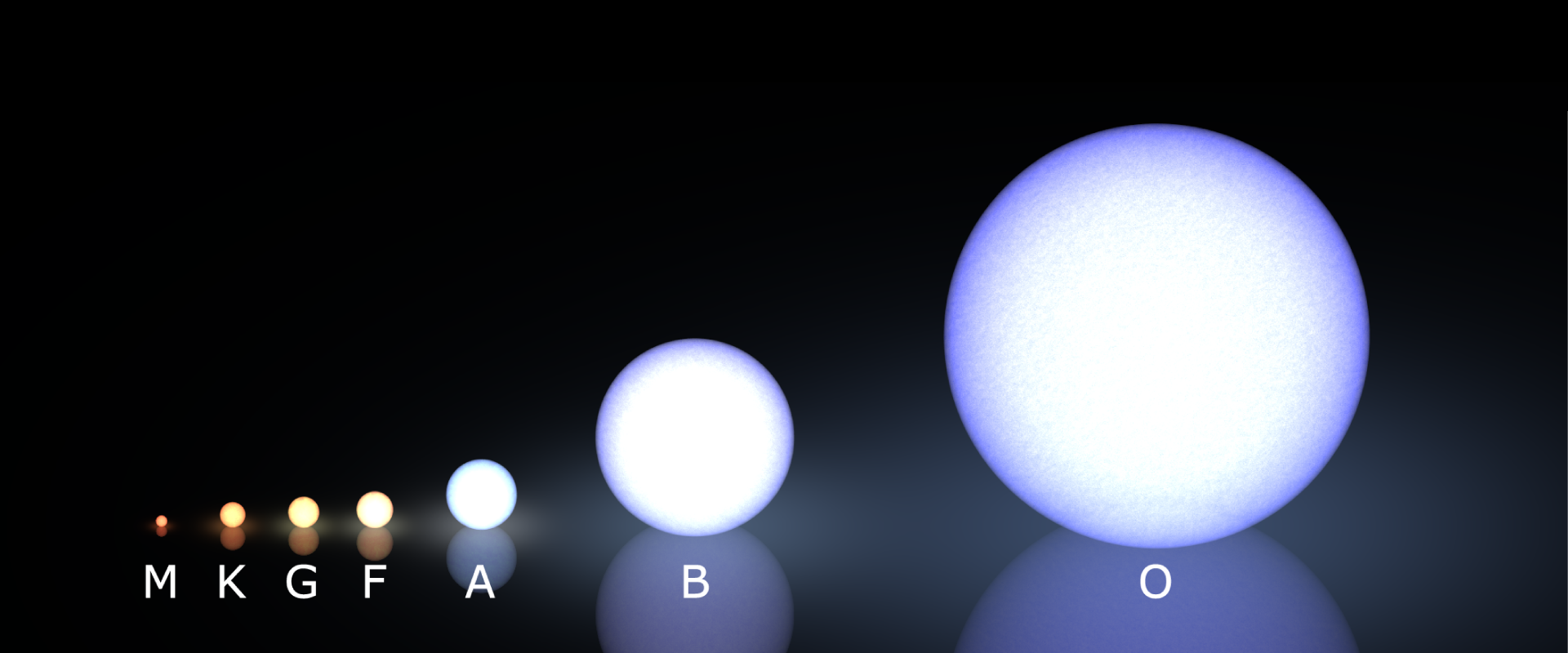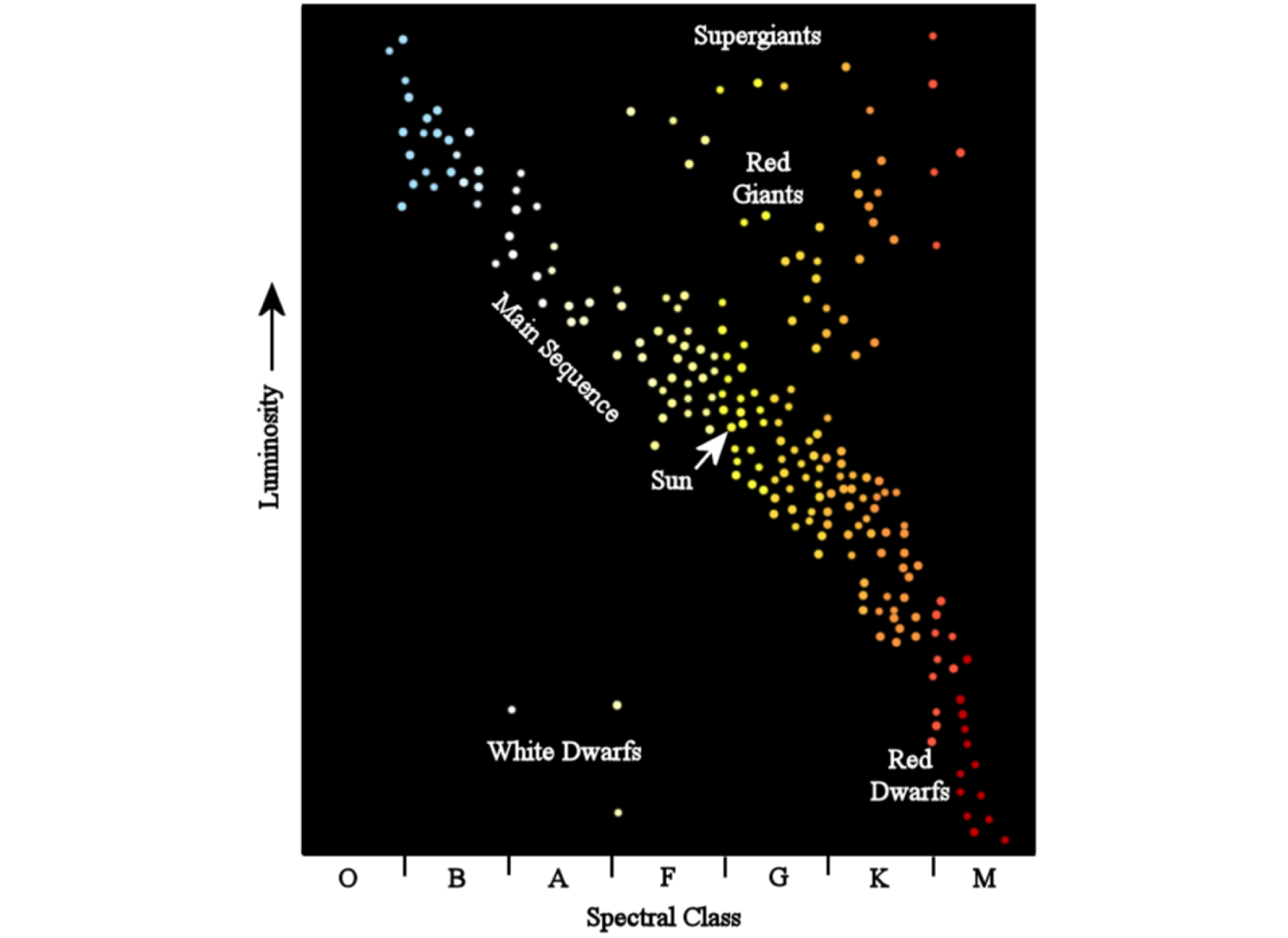Stars and their evolution
how the stars are classified,
to describe different types of stars.
Before you start, answer the questions.
What is the star?
What the galaxy is?
Stellar classification
The stellar classification is based on stars’ spectra. The stellar spectrum is characterised by three basic parameters:
temperature
gas pressure,
chemical composition.
In the Morgan‑Keenan (MK) system, there are seven main spectral types of stars ordered of decreasing temperature: O, B, A, F, G, K, and M. Each type has subclasses from 0 to 9 (hottest to coolest star of certain type e.g. B4, G7). The colour of a star is determined by its surface temperature.
star type | colour | approximate surface temperature (in K) | average mass (mass of the Sun = 1) | average radius (radius of the Sun = 1) | average luminosity (luminosity of the Sun = 1) |
O | blue | ≥ 30000 | ≥ 16 | ≥ 6,6 | ≥ 30000 |
B | blue | from 10000 to 30000 | from 2,1 to 16 | from 1,8 to 6,6 | from 25 to 30000 |
A | blue | from 7500 to 10000 | from 1,4 to 2,1 | from 1,4 to 1,8 | from 5 to 25 |
F | blue to white | from 6000 to 7500 | from 1,04 to 1,4 | from 1,15 to 1,4 | from 1,5 to 5 |
G | white to yellow | from 5200 to 6000 | from 0,8 to 1,04 | from 0,96 to 1,15 | from 0,6 to 1,5 |
K | orange to red | from 3700 to 5200 | from 0,45 to 0,8 | from 0,7 to 0,96 | from 0,08 to 0,6 |
M | red | from 2400 to 3700 | from 0,08 to 0,45 | ≤ 0,7 | ≤ 0,08 |

An additional parameter used in the classification is luminosityluminosity of a star (The Yerkes Luminosity Classes).
LuminosityLuminosity describes the brightness of a star (or galaxy). Luminosity is the total amount of energy that a star radiates each second (including all wavelengths of electromagnetic radiation).
The luminosityluminosity of stars is affected not only by their temperature, but depends also on the size of a star. The most luminous stars are these which are hot and large. For a group of stars with the same temperature, the luminosity class differentiates between their sizes (supergiants, giants, main‑sequence stars, and subdwarfs).
Luminosity class | Description |
0 | hipergiants |
Ia | bright supergiants |
Ib | supergiants |
II | bright giants |
III | normal giants |
IV | subgiants |
V | main‑sequence stars (dwarfs) |
VI | subdwarfs |
VII | white dwarfs |
The Hertzsprung‑Russell diagram
The relationship between the average surface temperature of stars (spectral type) and their absolute luminosity is presented by the Hertzsprung‑Russell diagram (the H‑R diagram). The absolute luminosityluminosity of stars is telling how brigth they would appear if they were all the same distance, equal to 10 parsecs.

Main sequence stars
Main sequenceMain sequence stars are the central band of stars on the H‑R Diagram. They are usually young stars. Their energy comes from nuclear fusion (conversion of hydrogen into helium). About 90% stars belong to the Main Sequence Stars.
The Sun is a G2V type star – a yellow dwarf.
Dwarf stars
Dwarf stars are relatively small stars. Their size can be up to 20 times larger than the Sun’s size and luminosityluminosity up to 20000 times higher.
Yellow dwarfs are small stars of spectral type G, a weight between 0,7 and 1 times the solar mass, and a surface temperature of about 6000°C. They are bright yellow or almost white. Yellow dwarfs are about 10% of stars in the Milky Way.
Red dwarfs are small, cool, very faint, main sequencemain sequence stars. Their surface temperature is under 4000 K. Red dwarfs are the most common type of star.
Giant and supergiant stars
To the giantgiant and supergiant stars belong mainly the old large stars.
Red giants
A red giant is an old star with a diameter about 100 times larger than it was at its beginning. Its surface temperature is under 6500 K.
Blue giant
A blue giant is a huge, very hot, blue star.
Supergiant
Supergiants are the largest known stars. Some of them are as big as our entire Solar System. They have extreme masses and hence relatively short lifetime of only 10 to 50 million years.
Dead stars
White dwarfs
White dwarfs are small, very dense, hot stars. They are remnants of red giantgiant stars. Their size is comparable with the Earth’s size, but these stars are much denser.
Neutron star
A neutron starneutron star: is a very small, very dense star. It is composed mostly of neutrons and has a thin atmosphere consisting of hydrogen. It has a diameter of about 5‑15 km.
Pulsar
A pulsarpulsar is a rapidly spinning neutron star. Its radiation can be observed only when the beam of emission is pointing toward the Earth.
Black holes
A black holeblack hole is a part of space where a great amount of matter is packed into a very small area. The gravitational field of black holes is so strong that nothing, no particles and no electromagnetic radiation can escape from inside it.
Evolution of stars
The radiation emitted by stars is a result of thermonuclear reactions taking place deep in their cores. In these reactions light elements are converted into heavier and enormous energy is released. There is enough pressure due to energy flow from the core to the outer parts of the star to keep it from collapsing under its weight. When nuclear reactions slow down due to the lack of elements a star starts to collapse. The dying star expands in the giantgiant or supergiant phase. The star will eventually explode and become a planetary nebula or supernova. Finally it turns into a white dwarf stardwarf star, neutron starneutron star or is getting a black holeblack hole. The final state of a star depends of its initial mass.
Remember
The star classification is based on stars spectra.
The relationship between the average surface temperature of stars and their absolute magnitude is presented by the Hertzsprung‑Russell diagram.
All stars undergo an evolution.
Exercises
Determine which sentences are true.
- A star during most of its life is called a main sequence star.
- Scientists consider red stars to be cold.
- The Sun’s visible light is created by the fusion of hydrogen atoms into helium.
- The Sun is red dwarf.
Order the following stars according to their decreasing luminosityluminosity: the Sun, white dwarf, a blue supergiant, a red giant.
Describe in English what types of stars you know.
Indicate which pairs of expressions or words are translated correctly.
- długość fali - wavelength
- jasność - luminosity
- karzeł - giant
- czarna dziura - black hole
- olbrzym - dwarf star
- gwiazda neutronowa - neutron star
- pulsar
- giant
- wavelength
- olbrzym
- dwarf star
- karzeł
- luminosity
- jasność
- pulsar
- długość fali
Glossary
czarna dziura
Nagranie dostępne na portalu epodreczniki.pl
wymowa w języku angielskim: black hole
karzeł
Nagranie dostępne na portalu epodreczniki.pl
wymowa w języku angielskim: dwarf star
olbrzym
Nagranie dostępne na portalu epodreczniki.pl
wymowa w języku angielskim: giant
jasność
Nagranie dostępne na portalu epodreczniki.pl
wymowa w języku angielskim: luminosity
ciąg główny
Nagranie dostępne na portalu epodreczniki.pl
wymowa w języku angielskim: main sequence
gwiazda neutronowa
Nagranie dostępne na portalu epodreczniki.pl
wymowa w języku angielskim: neutron star
pulsar
Nagranie dostępne na portalu epodreczniki.pl
wymowa w języku angielskim: pulsar
długość fali
Nagranie dostępne na portalu epodreczniki.pl
wymowa w języku angielskim: wavelength
Keywords
dwarf stardwarf star
giantgiant
luminosityluminosity
main sequencemain sequence
wavelengthwavelength